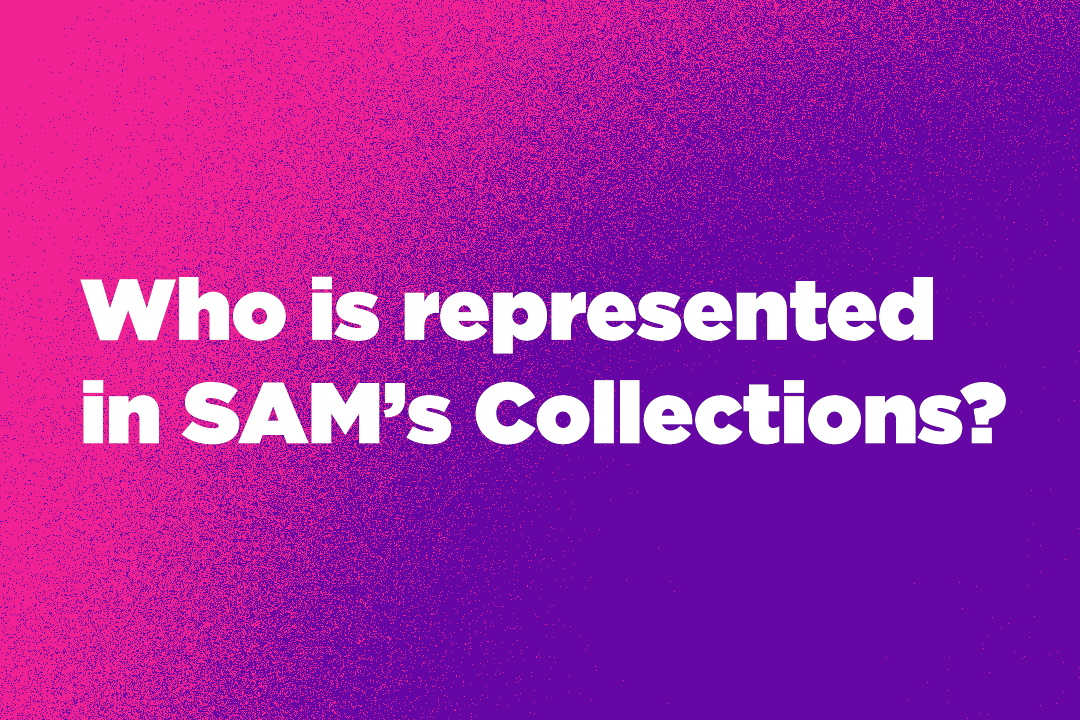Documenting Diversity in SAM’s Permanent Collections
Museums across the country are contending with the structural racism that shapes their collections and organizations. One component of this process, in striving for transparency, is assessing the individuals and communities who are—and who are not—represented in these collections.
In the summer of 2019, SAM’s Curatorial Department began the challenging—and ongoing—work of collecting data to better understand the diversity of the museum’s permanent collection. While I helped initiate this research, it was carried forward by one amazing and dedicated curatorial intern, Rachel Kim, whose time, energy, and care laid essential groundwork for future initiatives to increase the representation of artists of color at SAM.
The methodology that guides this undertaking is shaped by a study titled “Diversity of Artists in Major U.S. Museums,” published in March 2019 by a cross-departmental group of colleagues at Williams College in the departments of Statistics, Mathematics, Art, and Art History. The study used crowdsourcing to mine the online databases of 18 major American museums, inferring data related to artists’ ethnicities, genders, and geographic origins. As in the Williams College study, we focused our attention on artists whose identities are known to us, first conducting research to manually calculate representation by gender and, later on, ethnicity, within SAM’s permanent collection. The Williams College study relied on the crowdsourcing platform Amazon Mechanical Turk to gather data and, like much of such data collection, is subject to human error. Still, the study found that 85% of works in major U.S. museum collections are by white artists, and that 87% are by men. Works by Black artists make up just 1% of collections; works by Asian artists, 9%; and works by Latinx artists, 3%.[1]
I should pause here and note that the complexities and sensitivities of this research are many—there are often limited resources, including limited biographical information, available on a number of artists; many artists’ identities and orientations are intersectional or non-binary, and the application of one singular identity for the sake of data collection reduces the complexity of many artists’ backgrounds and biographies; and most important of all is how the artist personally chooses to identify. With this in mind, Rachel Kim thoughtfully reflected, “No person’s identity can be relegated to simple formulas and spreadsheet labels. With this recognition, I made it a priority to extract source material on an artist from the words of the artists themselves before turning to secondary accounts.” Many museums are beginning to conduct similar data collection and research, and some are even developing surveys to be sent to living artists during the acquisitions process; this way, the artist may self-identify and share details related to their own biography as they would like for it to be recorded.[2] It is crucial to acknowledge another limitation as well: this first phase of data collection, focusing on “individual, identifiable” artists, inherently privileges a Western perspective and valuation of a singular object with a singular, documented maker.[3]
Yet, as nuanced and imperfect as this data may be, it acts as a critical blueprint that reflects what SAM—like too many museums around the country—has known and knows must be corrected. We must confront the inherent biases and narratives that collecting histories, including our own, perpetuates. Serving the museum’s larger institutional goal of addressing racial inequity within its walls and collection, this research further underscores the need for increased investment in 20th- and 21st-century artists of color.
Focusing on the museum’s modern and contemporary collection as one example, roughly 7% of works are by artists of color. However, since 2010, this collection has also seen the number of works by Black artists increase by over one-third. Many of these acquisitions are directly linked to the Gwendolyn Knight and Jacob Lawrence Prize, a $10,000 award offered biannually to an early career Black artist, along with a solo exhibition at SAM. The first prize was awarded in 2009, and SAM has consistently acquired works by the exhibiting artists in the years since.
Looking at another data sample, SAM acquired approximately 1,360 works by 20th- and 21st-century artists since 2010. Of these, roughly 48% are by artists of color. In addition, well over two times the funds were spent on the purchase of 110 works by artists of color compared to 94 works by white artists. These numbers are heartening and signal the progress that an intentional approach can accomplish, though we acknowledge that our work is only beginning.
This research and its analysis is far from definitive or complete, but it is a helpful tool—a compass, perhaps—that can help guide current and future actions to correct the systemic and institutional racism that has invariably shaped the museum field. Supporting, representing, and investing in artists of color through exhibitions and acquisitions is just one part of this anti-racist work for SAM.
– Elisabeth Smith, SAM Collections & Provenance Associate
